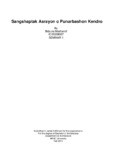Sangshaptak asrayon o punarbashon Kendro

View/
Date
2014Publisher
BRAC UniversityAuthor
Mosharraf, BidouraMetadata
Show full item recordAbstract
One out of every three women worldwide is a victim of violence—physical, sexual or psychological—throughout her life time. Considering, the global population of about 6 billion where women constitute nearly half of it, roughly ONE billion women have either faced, continues to face or will face abuse at the hands of perpetrators. Please note that, even though the degree of violence is more or less constant among countries, it has been found that the region of South East Asia has the highest rates of crimes committed against women; and within the boundaries of this region, countries such as India, Thailand and Bangladesh experience massive issues of violence against women (VAW). This is largely attributed to cultural and social conception of women as subordinate characters that is found common here.
Now, of the different forms of violence such as work place violence, rape, husbandry rape, acid attacks, arson and so on, the aspect of domestic violence trumps the rate of any other violence types by far, globally. The issue is the same in Bangladesh too. For instance, around 42 percent of women in rural areas and 40 percent women in urban areas in the country experience multiple forms of domestic violence. And this percentage is constantly escalating. It must be mentioned here that there are facilities provided all around the country to meet the basic needs of violence victims—domestic violence inclusive, which range from medical to legal, psychological to training aid and so on. However, such services are disparate and far in between, as a result of which women, unable to simultaneously avail all of the services required to help them come out of the violence situation continue to be victimized repeatedly and new victims surface. At the same time, due to the lack of adequate information dissemination and awareness facilities on the issue of VAW, not many people are knowledgeable about the consequences of VAW on the society, or the measures to be taken to curb VAW. This too, contributes to the constant increasing stream of violent activities against women.
In light of the current conditions and the fact that the current system of help provided is never holistic, an attempt has been made to design a system of rehabilitation facilities which would provide an overall healing system for female victims of domestic violence—Sangshaptak Asrayon o Punarbashon Kendro, that would address not only the existing victims of violence in terms of re-securing their identities and reintegrating them into the society by the virtue of providing them with information, medical aid, legal aid, psychological and occupational support, and transitional shelter, all simultaneously within one place, but also in terms of creating mass scale awareness and knowledge dissemination opportunities among both the victims and general population so as to eradicate domestic violence from the very roots of the society. Shangshaptak Asrayon o Punarbashon Kendro can thus be referred to as a place of ‗universal healing‘ where each and every one will be able to find a way of developing themselves--either to renew their broken identities or to become better human beings by learning to stand up against VAW and hence contribute to make a better society.
